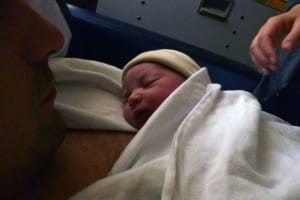Hello Parents!
Today, I want to talk about babywearing. Babywearing is carrying your baby against your body, using fabric to transport them rather than a stroller, for example. The benefits of babywearing for mother, father and baby are talked about more and more. Even in the hospital, after childbirth when skin-to-skin is essential. I find this amazing!
In this article:
- Skin-to-skin from birth
- The history of babywearing
- The benefits of babywearing for babies
- Babywearing options
- How to choose a baby carrier
Babywearing is a great way to reduce the shock for a baby that just left their warm nest and found themselves in a cold, bright world. You can babywear even if the baby is naked, skin-to-skin, against their parent in a fabric that surrounds and supports them. It’s a bit like an open-air uterus with a view! A nest that walks! Do you think babywearing is new? No, not at all, a babywearing has been practiced around the world for centuries, maybe even millennia.
Skin-to-Skin from Birth

In many birthing locations (maternity centres, hospitals) skin-to-skin contact between mother and baby is promoted the minute they arrive in the outside world. The baby is placed on the mother’s chest with a warm blanket over top. Depending on the situation, for example, a caesarean section, the other parent will be skin-to-skin with the baby. Their parents’ warmth, smell, heartbeat and voice will make the baby feel safer and regain their body heat lost during birth. This is also a great moment to develop attachment, a time to discover your baby, look at them and see them for real after having expected them for months. It can be very emotional for both mom and dad.
To learn more about babywearing, go to The History of Babywearing.


